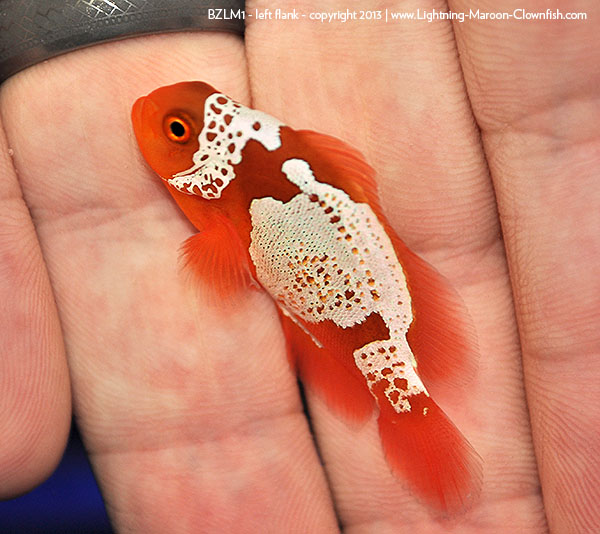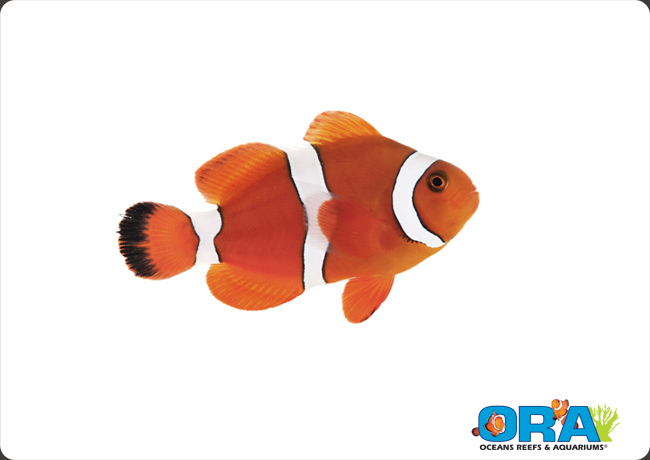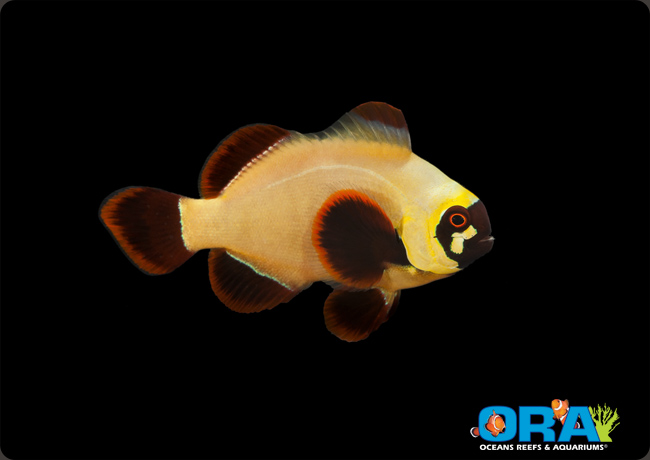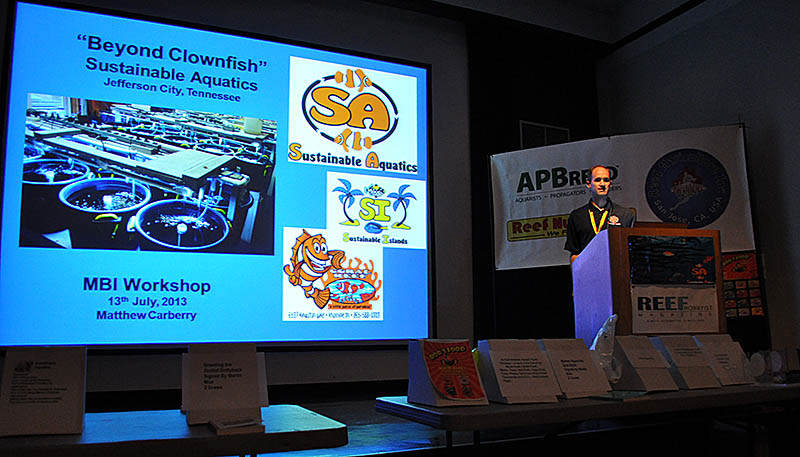This is the second part of our annual Marine Breeder’s Year in Review, part 1 can be seen here.
4th Annual Marine Breeding Initiative (MBI) Breeder’s Workshop
To say it’s been a busy year is an understatement, so much so that there was no time to write up the 4th annual MBI Workshop, put on each year by the Marine Breeding Initiative. This yearly event is rapidly becoming the annual, summer pilgrimage for fish and invert breeders from around the continent, with good reason. There is simply no other place on the planet where you’ll find this much ornamental marine breeding brain power all in the same place at the same time.
Every year, this event is held at the Cranbrook Institute of Science in Michigan at some point in late summer, precisely when most other aquarists are taking “breaks” from their tanks! When you show up at Cranbrook, you generally get the feeling that you’re not in the right spot. Case in point:
Seriously, this is the venue for the annual Marine Breeder’s Workshop! Access to the science museum is simply one more “perk” to attending this event, but the real reason breeders come together is to interact with speakers like these:





The success of the MBI Workshops, largely spearheaded by Tal Sweet and his team of leaders at MASM (Marineline Aquairum Society of Michigan) has caused the idea to “jump the pond”; Tal Sweet will be headlining the first ever Marine Breeder’s Day Out in the UK this coming February!

Clownfish ARE the Guppies of the Marine Aquarium World
I’ll wrap up the 2013 Year in Review by closing with Guppies. Yes, Clownfish truly are the guppies of the marine aquarium breeding, and NOT the Banggai. Sustainable Aquatics and ORA both led the charge with new designer types in 2013; I think with the advent of a Long-Finned Ocellaris, discovered in the juveniles at Sustainable Aquatics this year, once and for all the title has been clinched.

Sustainable Aquatics had their first longfin ocellaris spawn in December following a mate swap; as of December 18th, they shared:
“Mr. Longfin and Miss Fancy hatched a healthy nest of larvae two nights ago. We estimate that the hatch was in the neighborhood of about a couple hundred babies. They are swimming about happily and eating with good appetites….we do not know what we will find in this Longfin Hatch. We do not expect to learn much for at least 21 days. When the fish are gaining color, stripes, and fins we will post more pictures.”
So any day now we may have the next exciting installment of this story.
With this “guppy” title for clownfish comes the highs and lows associated with being the ubiquitous group of fish that anyone and everyone can breed. The release of the first F1 offspring of the Lightning Maroon Clownfish, sold at eBay auction by Blue Zoo Aquatics (with one of the first retailing for over $10,000), demonstrated that clownfish breeding is serious business, and the market is ripe and ready for new genetic variations of known species.

While the Lightning Maroon is proof that a carefully planned breeding project can bring a wild sourced mutation to the masses (as did ORA’s Picasso program years back), and can be used to educate on the topics of genetic variations vs. hybridization, not all clownfish breeding seems to be headed in a particularly enlightened direction.
Companies like ORA, Sustainable Aquatics, Sea & Reef, Proaquatix, Fisheye Aquaculture, all seem to have “heard the message” as it pertains to designer clownfish. As an outside observer, for the most part it seems that to some extent they have acknowledged each other’s work and have at times refrained from excessively playing the name game (that is slapping a new name on something that already has a name).
Now, we can’t always say that’s the case, but it does seem that these larger commercial breeders are, to some extent, trying to embrace a set of guiding principals that focus on quality and integrity of the breeder in what they produce, which includes being very transparent in what they are doing and marketing. When they get tangled up in the name game, they seem to either make a very valid point for applying a new name, or at the very least they acknowledge that they have changed the name and the fish is also known in the trade as something else. Absolutely not ideal, but far better than outright attempts to deceive.

Case in point; Sea & Reef kicked off the year releasing “DaVinci” Clowns, initially causing boatloads of confusion. First they were thought to be Percula, then recognized for the Ocellaris that they are, only to again be confused as Snowflake-derived, when in fact they are, all along, the “single dose” form of Wyoming White Ocellaris clownfish, a form which has already been around for years under various names including the original “Gladiator” from C-Quest (were the strain originated) and perhaps more commonly known as “Fancy White” out of Sustainable Aquatics.
Regardless of the name, those ‘in the know’ quickly recognized the fish for what it is, and if all else fails, Sea & Reef’s transparency of origin clarifies that this fish is the same as the others, but the average aquarist on the street might not realize it. Whether Sea & Reef should call these fish “DaVinci”, “Fancy White”, “Gladiator”, or some other name altogether is a debate that will continue for the time being.
ORA’s “Blood Orange” Clownfish is another example of how the naming debate will continue in the absence of any communally agreed upon standards. In the absence of hard standards, it may well be the decisions made by companies like ORA that set the tone for how the breeding community evolves.

The Blood Orange Clownfish is an intentional hybridization of the regular Orange Amphiprion ocellaris crossed with the Sumatran, or Gold Stripe Maroon Clownfish, Premnas biaculeatus. This primary hybrid (a hybrid between two pure species) technically has been done before – years before in fact, being known as the Cocoa Clownfish out of Proaquatix.
One might say that the Hybrid of Ocellaris X Maroon already had a name but the plot thickens, because the Cocoa from Proaquatix is purportedly the hybrid of the Darwin/Black form of Ocellaris and a Gold Stripe Maroon. Not surprisingly, the resultant Cocoa Clownfish does look different from the Blood Orange.
ORA’s fish is a new variety with a different genetic basis and outcome, and therefore would be deserving of a new moniker. Toss into the mix that some aquarists speculate that the Darwin Ocellaris and regular Ocellaris are different species, not to mention the supposition that the Gold Stripe and White Stripe Maroons might also one day be worthy of taxonomic separation, and you quickly realize that the name applied to something even slightly different at this point in time may have profound implications on future breeding.
We should also point out that clownfish weren’t the only family of marine fish to get the hybrid treatment; ORA also introduced the new Black Neon Dottyback, Pseudochromis (aldabraensis x springeri). Once again, since we continue to lack a universally and communally accepted framework for the tracking and naming of genetic variations and hybridization, the “wild west” will continue in the designer clownfish realm.
This problem with this naming convention, or lack thereof, might best be illustrated by the seemingly massive numbers of clownfish breeders who’ve cropped up all over the place, each with their own latest and greatest new variety that somehow only they have and no one else could possibly ever have.
With at least one online vendor (lookin’ at you, Alpha Aquaculture) becoming established by simply offering WYSIWYG designer clownfish from every breeder they can obtain them from, it seems that designer clownfish have practically become “collectibles”, almost the Pokemons of the marine aquarium world among the breeders and aquarists who covet them.
They are the Chalice chips, the single polyp zoanthid frags of the fish world at the moment. When this type of tulip-mania takes root in the clownfish world, the phrase “buyer beware” applies now more than ever before. The best advice one can offer is this – as a breeder you really have your homework cut out for you to determine what you’re being offered; as a general consumer, you may well be best to ignore the name, and simply value the fish you buy based on their aesthetic merits weighed against your pocketbook’s willingness to pay for it.
Still, when it comes to genetic variations, there is something alluring based on the notion that they can be “bred out” and are not the problem that hybridization can be in preserving species lines. Several unique new presumed genetic variants really caught my eye this year. The first was the “Galaxy” or “Picasso” Tomato Clownfish (Amphiprion frenatus) from Bali Aquarich.

Whether we’ll see these unusual Tomato Clowns in the future or not may well depend on whether these unique fish actually hold their unusual patterns, or lose them as they mature (Tomato Complex fish are known to have multiple juvenile stripes that are lost as the fish grow, and so these attractive markings might be short lived). Nevertheless, the fact that this type of over-barring mutation is being seen in virtually every clownfish species complex suggests that something universal is breaking in the striping mechanism, not unlike finding Orange Blotch mutations across numerous species of African Cichlids.
ORA’s work with the Gold Flake and Gold Nugget Maroon Clownfish proved hands down that there was “room for improvement” in the Standard Gold Stripe Maroon variety.

The genetic inner workings of these new Maroon Clownfish forms have yet to be disclosed by ORA, but it wouldn’t be surprising to learn that “Gold Flake” is comparable to Picasso in Percula, and “Gold Nugget” is comparable to the Platinum Percula. While this is speculation, we might be seeing the same over-barring mutation manifesting itself in yet another clownfish species with admittedly very attractive results.
While the jury is still out on Sustainable’s Long Finned Ocellaris project, SA did show us how the doubling up of unrelated genetic traits can create something new with their release of the Frostbite Clownfish. Stepping aside from species-oriented personal breeding focus, work with freshwater Angelfish (and the numerous known genetic mutatations that make up our endless domestic forms) tells us that the Frostbite is an exciting concept for the Ocellaris Breeder.

Here is a fish that has more than one genetic mutation accumulated within it, and when bred together could yield a large array of diverse forms in the progeny. In other words you might get a half dozen or more unique genetic variations as a result, each one every bit as pure and unique as you’d find anywhere else.
I already have an angelfish pair that throws something in the neighborhood of 32 unique phenotypes in the offspring; take the Frostbite and add in some Tangerine Albino and Longfin genetics and suddenly a single pair of clownfish could yield upwards of a dozen uniquely identifiable forms!
Suddenly the mom and pop home breeder’s list, instead of simply listing “ocellaris clownfish”, might list a half dozen or more unique forms, all of which happen to come from the same parents. While this is wonderful for the tiny breeder, there is a downside to all this – broodstock population sizes might decrease as breeders would need to keep fewer pairs on hand to get the diversity they want, the net result being more and more inbreeding as the years go by. It’s an interesting conundrum I don’t think we’ve had to consider before.
Despite all the designer madness, it’s noteworthy to point out that valuable work was done bringing new natural forms and geographic variants into culture this year.
While no new species of clownfish was bred this year (there’s really only one or two species out there that have never been done), Sustainable Aquatics led the charge revisiting Saddlebacks, true Sebaes, and Black Clarkis. ORA paid special attention to their long-standing Rubrocinctus line and finally confirmed what had been suspected – this line of fish is actually the Fijian Amphiprion barberi.
ORA has also teased a look at captive production of the rare Whitebonnet Clownfish, A. leucokranos,which is generally thought to be a naturally occurring hybrid and not a true species. ORA is promising availability in early 2014; clownfish collectors are indeed excited and ORA maybe be in a position to offer valuable insights on the suspected hybrid nature of these fish, as evidenced by the resultant offspring they’ll raise.
[youtube]https://www.youtube.com/watch?v=MM5ry-1g7ao[/youtube]
So what does 2014 have in store?
It’s safe to say we’ll probably see another Angelfish species or two added to our list of “accomplished species” in 2014; this seems to be where people are throwing their R&D efforts.
We no doubt will see more hybrid clownfish and other attempts at doing something “different” in the designer clownfish realm, although how truly “unique” or “desirable” these “new” forms actually are may be up for debate. Unless a new mutation is discovered (perhaps a rediscovery of classic albino, or a xanthic or unique melanistic form), we will probably see more rehashing of the same old mixed lineage fish.
I still believe we will see the rise of a longfin Ocellaris line from Sustainable Aquatics, and it is possible if not likely that we might see the first Lightning X Lightning progeny produced by one or more breeders who are working with the F1 fish. While Longfin has yet to be proven genetic, I assume it will be, and Lightning is still in its infancy of genetic understanding as well. Both mutations have answers waiting to be discovered.
We will also see more “revisiting” of species that have been accomplished in the past but haven’t been available in years or decades, particularly as demand for captive bred species continues to increase. I expect Chad Vossen to produce more captive-bred Harlequin Filefish than I ever did. The recent availability in late 2013 of captive-bred Catalina Gobies (Lythrypnus dalli) is further evidence of this trend.
We should also expect to see “more of the same”, that is to say any difficult to find species that is related to an easy-to-breed family of fish is a prime candidate for investigation and production. Rare fang blennies and dragonets are two groups I’d expect to see added to the species list as the difficulty lies mainly in obtaining the broodstock rather than identifying new breeding and rearing techniques. Along these same lines, I would not be surprised to see a new grunt species added to the mix either.
How much larger will the captive-bred list grow to be by the end of 2014? We’re at 250 species plus already; it’d be a milestone acheivement to hit something in the ballpark of 300. More realistically, I put next year’s total at 275. Check back in a year to see how my forecasts have gone!








